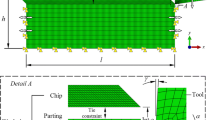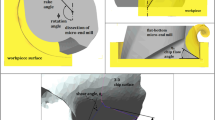Abstract
A numerical simulation analysis of mechanical chip morphology and residual stress for Ti6Al4V alloy was conducted under different cutting speed and feed rate. Johnson-Cook constitutive model and shear failure model were selected in the simulation procedure. The correlations between the mechanical chip morphology and surface residual stress were detailed. The results show that the chip morphology characterized with the degree of serration Gs and the serrated frequency f has a direct impact on residual stress distribution. With the increase of the degree of serration Gs, the maximum residual tensile stress decreases, while with the increase of the serrated frequency f, the maximum residual compressive stress increases on the surface. The research of the present paper provides a new way to understand and evaluate residual stress distribution for titanium alloy mechanical process.
Similar content being viewed by others
Abbreviations
- \({\bar \sigma}\) :
-
Equivalent stress
- \({{\bar \varepsilon}^{pl}}\) :
-
Equivalent plastic strain
- \({{\dot \varepsilon}_0}\) :
-
Strain rate
- \({{\dot \bar \varepsilon}^{pl}}\) :
-
Reference strain rate
- T room :
-
Room temperature of Ti6Al4V
- T melt :
-
Melting temperature of Ti6Al4V
- D:
-
Damage variable (stiffness degradation factor)
- G f :
-
Fracture energy
- L :
-
Element characteristic length
- \(\bar u\) :
-
Equivalent plastic displacement
- σ y :
-
Yield strength of the material
- h 1 :
-
Height of the peak
- h 2 :
-
Height of the valley
- d :
-
Spacing of the serrated chip
- f :
-
Geometrical characterization parameters of the serrated frequency
- G s :
-
Geometrical characterization parameters of the degree of serration
- V :
-
Cutting speed
- ϕ :
-
Adiabatic shear angle
- d :
-
Spacing of the serrated chip
References
Z. P. Wan et al., Microstructure evolution of adiabatic shear bands and mechanisms of saw-tooth chip formation in machining Ti6Al4V, Materials Science & Engineering A, 531 (2012) 155–163.
Q. B. Yang, Formation Mechanism and Characterization of Serrated Chip in High Speed Machining, Shandong University (2012) (in Chinese).
B. Zhang and A. Bagchi, Finite element simulation of chip formation and comparison with machining experiment, J. of Engineering for Industry, 116(3) (1994) 289–297.
T. Mabrouki et al., Numerical and experimental study of dry cutting for an aeronautic aluminium alloy (A2024-T351), International J. of Machine Tools & Manufacture, 48(11) (2008) 1187–1197.
R. Hossein, N. Salman and J. A. Hamed, Analysis of welding parameters effects on microstructural and mechanical properties of Ti6Al4V and AA5052 dissimilar joint, Journal of Mechanical Science and Technology, 32(7) (2018) 3371–3377.
D. Umbrello, Finite element simulation of conventional and high speed machining of Ti6Al4V alloy, J. of Materials Processing Technology, 196(1–3) (2008) 79–87.
X. Q. Zhang and X. P. Zhang, Ti 6Al 4V high-speed cutting process experiment and finite element analysis, Machine Design & Research, 28(4) (2012) 92–89 (in Chinese).
C. Hortig and B. Svendsen, Simulation of chip formation during high-speed cutting, J. of Materials Processing Tech., 186(1) (2007) 66–76.
R. Ambati and H. Yuan, FEM mesh-dependence in cutting process simulations, International J. of Advanced Manufacturing Technology, 53(1–4) (2011) 313–323.
T. Özel and D. Ulutan, Prediction of machining induced residual stresses in turning of titanium and nickel based alloys with experiments and finite element simulations, CIRP Annals — Manufacturing Technology, 61(1) (2012) 547–550.
L. Chen, T. I. El-Wardany and W. C. Harris, Modelling the effects of flank wear land and chip formation on residual stresses, CIRP Annals — Manufacturing Technology, 53(1) (2004) 95–98.
Y. H. Fan et al., Surface residual stress in high speed cutting of superalloy Inconel718 based on multiscale simulation, J. of Manufacturing Processes, 31 (2018) 480–493.
R. Wang et al., Effect of temperature on the magnetic abrasive finishing process of Mg alloy bars, Journal of Mechanical Science and Technology, 32(5) (2018) 2227–2235.
G. R. Johnson and W. H. Cook, A constitutive model and data for metals subjected to large strains, high strain rates and high temperatures, Proceedings of the 7th International Symposium on Ballistics (1983).
W. S. Lee and C. F. Lin, High-temperature deformation behaviour of Ti6Al4V alloy evaluated by high strain-rate compression tests, J. of Materials Processing Technology, 75(1–3) (1998) 127–136.
Editorial Committee of China Aeronautical Materials Handbook, China Aeronautical Materials Handbook: Vol.4: Titanium Alloys & Copper Alloys, 2nd ed., Stand Press China, Beijing, 104–107 (in Chinese).
D. R. Lesuer, Experimental investigations of material models for Ti-6Al-4V titanium and 2024-T3 aluminum, Design (2000).
A. Hillerborg, M. Modéer and P. E. Petersson. Analysis of crack formation and crack growth in concrete by means of fracture mechanics and finite elements, Cement & Concrete Research, 6(6) (2008) 773–781.
N. N. Zorev, Inter-relationship between shear processes occurring along tool face and shear plane in metal cutting, International Research in Production Engineering, ASME, New York, 49 (1963) 143–152.
Y. Zhang et al., FE-model for Titanium alloy (Ti-6Al-4V) cutting based on the identification of limiting shear stress at tool-chip interface, International J. of Material Forming, 4(1) (2011) 11–23.
G. Chen et al., Finite element simulation of high-speed machining of titanium alloy (Ti-6Al-4V) based on ductile failure model, International J. of Advanced Manufacturing Technology, 56(9–12) (2011) 1027–1038.
H. Schulz, E. Abele and A. Sahm, Material aspects of chip formation in HSC machining, CIRP Annals — Manufacturing Technology, 50(1) (2001) 45–48.
D. M. Turley, E. D. Doyle and S. Ramalingam, Calculation of shear strains in chip formation in titanium, Materials Science & Engineering, 55(1) (1982) 45–48.
X. Zhang, S. Wu and C. Liu, Hook shaped residual stress: The effect of tool ploughing, and the analysis of the mechanical and thermal effects, ASME 2012 International Manufacturing Science and Engineering Conference (2012) 277–286.
Acknowledgments
The present research was supported by the Jiangsu Province Natural Science Foundation of China (No. BK20180440).
Author information
Authors and Affiliations
Corresponding author
Additional information
Z. R. Wu currently teaches in the College of Energy and Power Engineering, Nanjing University of Aeronautics and Astronautics, Nanjing, Jiangsu, China. He received his Ph.D. from Nanjing University of Aeronautics and Astronautics, China, in 2014. His research interests include fatigue and durability of components and structures.
Rights and permissions
About this article
Cite this article
Wu, Z.R., Zhu, K.K., Pan, L. et al. Investigation of the correlation between mechanical chip morphology and surface residual stress for Ti6Al4V alloy. J Mech Sci Technol 34, 3997–4004 (2020). https://doi.org/10.1007/s12206-020-2210-0
Received:
Revised:
Accepted:
Published:
Issue Date:
DOI: https://doi.org/10.1007/s12206-020-2210-0




